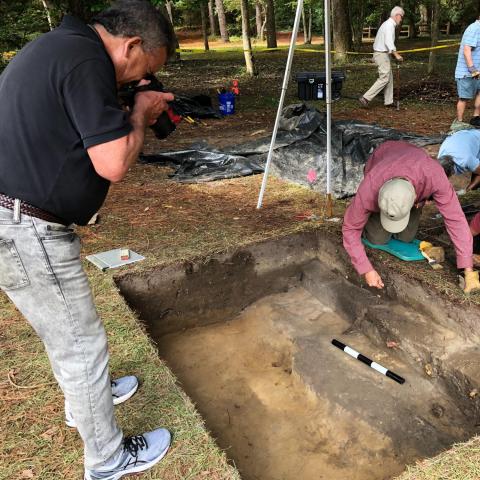
This house, photographed by debris from a neighboring house that collapsed early Friday morning, collapsed Friday night/NPS
Crews went to work Saturday at Cape Hatteras National Seashore to clean up the debris of a second house that collapsed into the Atlantic Ocean in less than 24 hours, bringing to nine the number of homes toppled by the ocean in recent years.
The vacant structure at 23009 G.A. Kohler Court in Rodanthe, North Carolina, fell into the waves around 9 p.m. Friday, a day that dawned with news that the house next door had been pulled down. Seashore law enforcement rangers arrived on scene Friday night and confirmed that the one-story house—the same house that sustained damages as a result of the first house collapse of the day—had collapsed and apparently washed out into the ocean before the bulk of it returned to the beach at the south end of G A Kohler Court.
National Park Service officials urged visitors at the north end of Rodanthe and for miles to the south to stay out of the water and wear hard-soled shoes when walking on the beach to avoid injuries from hazardous floating debris and nail-ridden wooden debris. Due to potentially dangerous debris on the beach and in the water to the north and south of the collapse site, temporary beach closures for public safety may be necessary, they added in a release Saturday morning.
Seashore staff was in communications with the property owner of 23009 G A Kohler Court and expected a contractor to be secured for debris cleanup. Park Service staff were on the beach again Saturday to assist with moving debris above the high tide line. As of Friday afternoon, varying levels of debris associated with the collapse of 23001 G A Kohler Court were observed approximately nine miles to the south of the collapse site.
Read what National Park Service officials are faced with at Cape Hatteras National Seashore.
The second collapse of the day Friday marked the fourth structure to be lost to the ocean this year.
When the houses were first constructed, they were outside the national seashore's boundary, which reaches up to the high tide line on the beaches. But as years have gone by and storms have come and gone, the beachfront has been eroded away to where it is now, with the high tide swirling around the pilings that the houses stand on.
The situation has placed the Park Service in a difficult position, as it's job is to preserve parks unimpaired for future generations, but so far the national seashore staff has not taken any legal action to order the removal of additional homes in danger of collapse, or condemn them, so the homeowners might be able to collect insurance once they do collapse, though it has discussed the issue with Interior Department lawyers.
Last year the Park Service used $700,000 from the Land and Water Conservation Fund to purchase two houses at risk of being toppled and worked to have them removed.


 Support Essential Coverage of Essential Places
Support Essential Coverage of Essential Places







Add comment